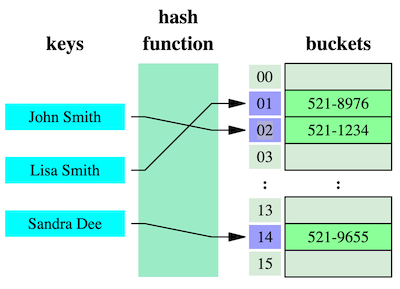Hash Table
A hash table is a key-value pair data structure that provides constant time data access, using a Hash Function to convert a key into a numeric array index.

Diagram by Jorge Stolfi via Wikipedia
It's considered a Linear Data Structure as elements in the array are stored sequentially.
Two keys can produce the same index, called a collision, depending on the implementation. There are multiple common techniques to resolve hash collisions:
Rehashing
- Enlarge the hash table (e.g., double its size)
- Update the hash function's reduction function (modulus part)
- Re-hash all existing numbers into the new table
- Can be implemented reactively (after collision) or proactively (based on load factor threshold)
Linear Probing
- When a collision occurs, check the next available bucket
- Store the colliding number in the first empty bucket found
- Continue this process until an empty spot is found
Separate Chaining
- Create a chain (linked list) at each position in the hash table
- When collisions occur, add the new number to the chain at that position
- Chains can grow and shrink as needed
Hash tables typically have these core operations:
- Insert: add a new key-value pair.
- Search: look up a value by its key
- Delete: remove a key-value pair.
Under good conditions, these operations take an average time, making hash tables extremely efficient for storing and retrieving data.
Load Factor
The load factor of a hash table is calculated by storing the number of stored key by the number of buckets.